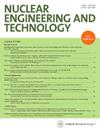关于 2×1、3×3 和 5×5 棒束子通道中混合的尺寸效应的数值研究
IF 2.6
3区 工程技术
Q1 NUCLEAR SCIENCE & TECHNOLOGY
引用次数: 0
摘要
混合叶栅(MVG)被认为是燃料组件中最重要的部件之一,它不仅起着支撑棒束的作用,还能提高反应堆堆芯中的临界热通量(CHF)。对棒束中的流动行为进行建模和精确测量,是了解和学习燃料组件中复杂栅格性能以及开发高性能 MVG 的关键。反应堆堆芯中的燃料组件通常由 17 × 17 或 16 × 16 的棒束组成,很难使用原始 MVG 进行研究。我们采用了具有代表性的较小原型网格。不同尺寸的杆束包括 1 × 1、2 × 1、3 × 3 和 5 × 5 等。较小尺寸的杆束如何成为能充分反映反应堆堆芯中真实流动和传热行为的原型是一个绝对的问题。本文研究了 2 × 1、3 × 3 和 5 × 5 尺寸下棒束尺寸对流动和传热的影响。首先,研究了 2 × 1 的边界设置,并将表面平均二次流和间隙处的局部流与 5 × 5 的结果进行了比较。然后比较了过冷流条件下 3 × 3 和 5 × 5 的管束尺寸。分析了中心子通道的温度和空隙率分布。讨论了非原型冷壁对传热的影响。研究表明,不同尺寸的管束会在棒束内产生不同的流动现象,其流动模式可能与反应堆堆芯燃料组件不尽相同,因此应根据研究目的选择典型的管束尺寸。本文章由计算机程序翻译,如有差异,请以英文原文为准。
Numerical study on the size effect on the mixing in 2×1, 3×3 and 5×5 rod bundle subchannels
Mixing Vane Grid (MVG) is considered as one of the most important components in the fuel assembly which not only plays the role of supporting the rod bundles but also improves the Critical Heat Flux (CHF) in the reactor core. Modeling and measuring the flow behavior accurately in the rod bundle is the key to understanding and learning complex grid performance in the fuel assembly and will develop high performance MVG. Usually, the fuel assembly in the reactor core consists of 17 × 17 or 16 × 16 rod bundles, it is hardly to use the original MVGs to perform study. The representative smaller prototypical grids are applied. Different bundle sizes are used including 1 × 1, 2 × 1, 3 × 3 and 5 × 5 et al. It is an absolute question of how the smaller size rod bundles are prototypical that could fully reflect the true flow and heat transfer behavior in a reactor core. In this paper, the effect of bundle size on flow and heat transfer is investigated under sizes of 2 × 1, 3 × 3 and 5 × 5. Firstly, the boundary settings in 2 × 1 are studied and the surface averaged secondary flow and local flow at the gap with 5 × 5 results are compared. Then the 3 × 3 and 5 × 5 bundle sizes are compared under subcooled flow. The center subchannels temperature and the void fraction distributions are analyzed. The effect of non-prototypical cold walls on heat transfer is discussed. The study shows that, different bundle sizes will produce different flow phenomena in the rod bundle, the flow pattern may not be the same with the reactor core fuel assembly, the typical bundle size selection should be based on the research purpose.
求助全文
通过发布文献求助,成功后即可免费获取论文全文。
去求助
来源期刊

Nuclear Engineering and Technology
工程技术-核科学技术
CiteScore
4.80
自引率
7.40%
发文量
431
审稿时长
3.5 months
期刊介绍:
Nuclear Engineering and Technology (NET), an international journal of the Korean Nuclear Society (KNS), publishes peer-reviewed papers on original research, ideas and developments in all areas of the field of nuclear science and technology. NET bimonthly publishes original articles, reviews, and technical notes. The journal is listed in the Science Citation Index Expanded (SCIE) of Thomson Reuters.
NET covers all fields for peaceful utilization of nuclear energy and radiation as follows:
1) Reactor Physics
2) Thermal Hydraulics
3) Nuclear Safety
4) Nuclear I&C
5) Nuclear Physics, Fusion, and Laser Technology
6) Nuclear Fuel Cycle and Radioactive Waste Management
7) Nuclear Fuel and Reactor Materials
8) Radiation Application
9) Radiation Protection
10) Nuclear Structural Analysis and Plant Management & Maintenance
11) Nuclear Policy, Economics, and Human Resource Development
 求助内容:
求助内容: 应助结果提醒方式:
应助结果提醒方式:


